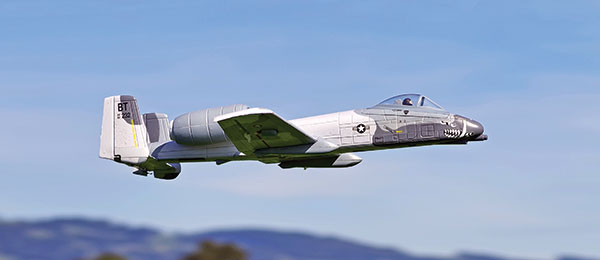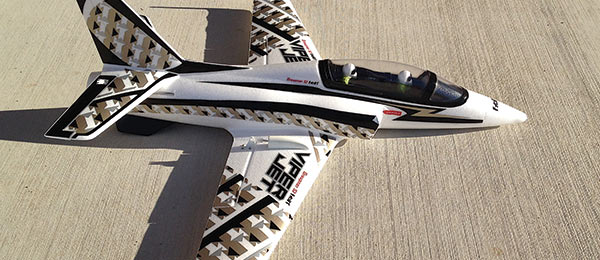
By Eric Henderson. Photos Eric Henerson. Full review in the Summer 2015 Park Pilot.
When I was living on the East Coast, it meant that the WRAM (Westchester Radio Aero Modelers) Show at the end of February kicked off my RC season each year. Living in Nevada now means that my RC season begins with the AMA Expo (amaexpo.com) in Ontario, California, in early January. AMA Expo has been adding vendors through which I can get new “stuff” and can stock up on essentials such as CA glue, carbon-fiber rods, etc. Every year I find something neat to buy, and this year was no exception. As the new owner of a Graupner (www.graupner.de/en) MZ-24 transmitter, I added an MZ-18 as a backup transmitter and to use as a wireless buddy box. These radios come with a six- and 12-channel receiver, but you can always use more. In particular, the Graupner 3xG receivers were on my list. They have a built-in primary control stabilization system. The difference for me was in the transmitters. The MZ transmitter lets me switch the stabilization on and off in flight. In addition, I can select a slider or rotary knob control to vary the levels of stabilization from the transmitter. This can be done individually for elevator, aileron, and rudder. The benefit is that you don’t have to land and reconnect to a computer to change a setting. It’s very field friendly! When you have the stabilization that you like, you make a more permanent setting and dispense with the dial mixes. You can still make these settings into an on/off mix. You might want to do this if you are concerned about wearing out your servo potentiometers with excessive stabilization activity. So, how does this relate to purchasing more receivers? Well, Graupner has several airplanes that come fitted with receivers that will bind to your Graupner transmitter. I picked up three park flyers: a T-28 US training aircraft and a P-47, both with a GR-12 3xG gyro receiver, and the Viper Jet 720 28-inch EDF (electric ducted fan).
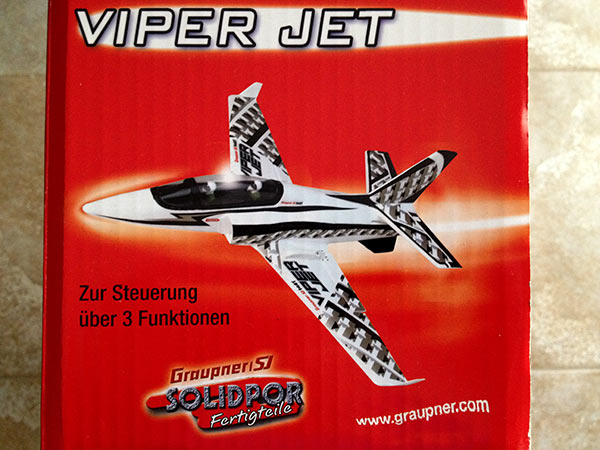
My trip to the 2015 AMA Expo helped me produce a Graupner Viper EDF jet that is pretty good for park flying.
There are two sizes of the Viper EDF: 30 inch and 56 inch. The latter is balsa and plywood construction. The 30-inch is a foamie and was just what I was looking for as EDF park flyer material for this column. There is not much to do to get the 30-inch Graupner Viper in the air. It comes with a prefitted EDF with a HPD 2510-4300 7.4-volt brushless motor. I initially believed I needed to find a 2S LiPo battery in the 850 mAh range, but farther down in the instructions, it stated that I needed a 3S 11.1-volt 30C LiPo. The 3S proved to be the correct battery. I did have to fit control horns to the elevators and ailerons. Although they are held on by screws, I like to add a dab of medium CA glue to the foam before tightening. The Viper uses foam that works well with CA and an activator (kicker). The aileron horns protrude from the top surface of the wing, which prevents any landing damage. The Viper does not employ any landing gear, and grass landing areas are a must! The ailerons are positioned inboard, which lets you use them as flaps. I wondered how effective they would be. There was only one way to find out. You are required to glue on the Viper’s wing, stabilizer, and fin. There is no rudder in the fin, although I am sure it would not be too hard to fit one without much of a weight penalty. There is a hatch to gain access to the EDF unit. The canopy is held on by strong magnets. A feature that I had not seen before was that the nose cone is also held on with magnets. I think the intent is for it to come off easily during landings if the Viper’s nose digs into the grass. The wings have little winglets that initially look fragile until you see the plastic supports that have been designed into them. The GR-12 3xG receiver supports stabilization on both the left and the right ailerons, which means that you can use radio functions such as flaperons and airbrakes. The MZ-24 handles this with both ease and clarity. Because the ailerons are positioned inboard and there is almost an equal amount of wing going out to the tip, I selected roughly 1/4 inch of down flaps for the two ailerons.
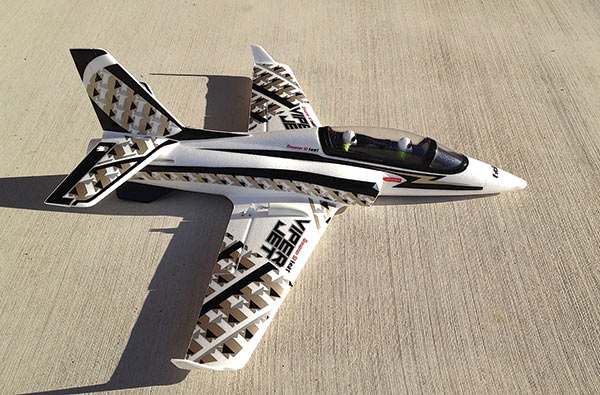
It took no more than an hour to glue the Graupner Viper EDF jet’s four parts together with CA glue and connect the ailerons and elevators. Servos were included.

Aileron pushrods come out of the top surface of the wing and have fairings to keep the air clean.
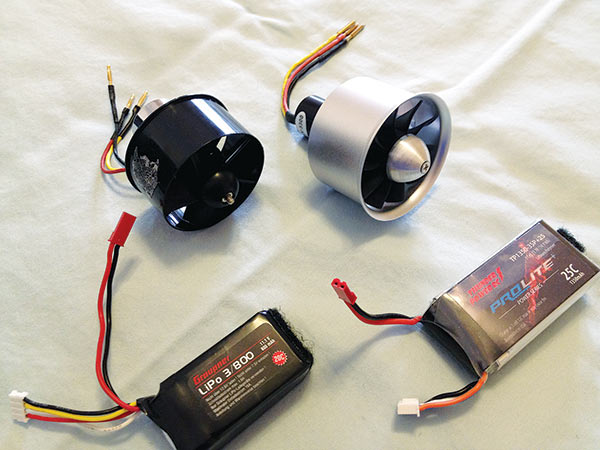
The original ducted fan worked fine, but putting in a Dr. Mad 10-blade EDF unit was too tempting.
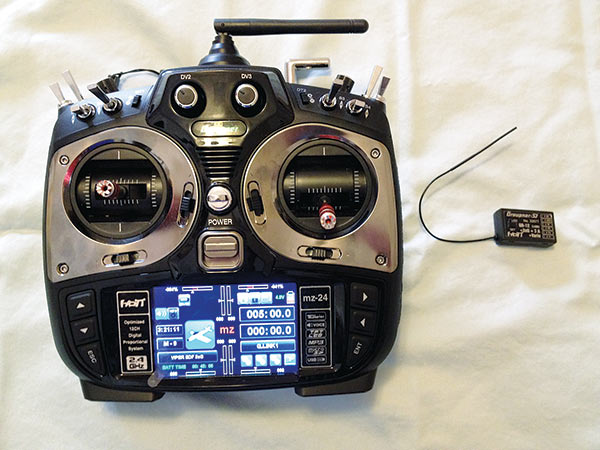
The MZ-24 has the computer power to program in-flight adjustable and on/off gain control for multiaxis stabilization.
I set the failsafe and did some programming to make my gain mixes adjustable in flight. I set two timers. One was a countdown controlled by a switch, and the other a count up with a 7-minute alarm. The second timer measures how much time I will be using power. There was not much left to do except fly! While at the field, I recruited a younger arm for the Viper’s first launch and turned on the timer, but then said, “Hold up!” The control checks were fine, but with axis stabilization, you also need to check that the gain corrections are going the right way. I turned them on and rolling the airplane left gave me automatic right-roll correction. Pushing the nose down gave me automatic up-elevator correction. All was good, so I turned the stabilization off and readied myself for the launch. Full power produced a high-pitch whine and the aircraft was off into the blue yonder. The ailerons were too sensitive, so I clicked in my lowest rate. So much for the fear that the inboard ailerons would not be responsive! Elevator was just right. After a couple of passes, rolls, and loops, it was time to try the Graupner 3xG system. Click! The Viper flew much smoother. In later flights, I dialed the auto-correction gains down to 50% and set them there for good. I put the aileron rates back to high and the flight was much smoother, however, whenever I “helped” the Viper roll, it was still super quick unless I was miserly with the stick inputs. I went back to low aileron rates with a mental note to dial them down mechanically. It was time to land. My preference is to land with the gains turned off. This is based on observations of how stabilization behaves at slow speeds. It seems to fight the attempts to flair. I left the gains turned on until the final leg, which helped me keep the wings level on the hard-to-see downwind leg. With the gains off, the landing was easy and the nose held up nicely. The magnets held the nose cone in place. I liked the look and the performance of the stock setup, but waiting in a box in my shop was a Dr. Mad (hobbyking.com) 50mm 10-blade EDF unit with “Viper Me” written on it. The whoosh sound of those extra blades was worth the work to change the units. The 850 mAh 3S LiPo battery pack was swapped for a 1,300 mAh pack to balance the extra weight of the new EDF in an aluminum case. The controls were already fine-tuned and a firm hand launch was all that was needed. The Viper starts to fly early in the launch, and as long as you keep it level (not nose up) the acceleration is brisk. Flight performance was about the same, probably because of the extra weight of the 1,300 mAh battery pack. The sound was gorgeous and almost too quiet. It is easy to fly too long. I will be fitting it with a Graupner LiPo monitor and setting the MZ alert for 10.0 volts to give me landings with some power still available.




